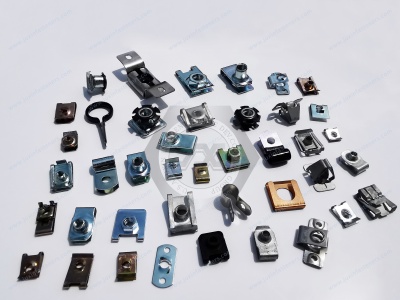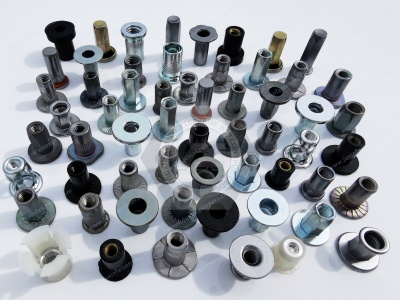Call Us
+86 136 6007 9809
Call Us
+86 136 6007 9809
Jun. 13, 2024
Anti-loosening solutions for high-strength bolts in automotive chassis
Anti-loosening strategy for high-strength bolts in automobile chassis
1. Tightening torque
In the automobile production assembly process, to improve the reliability of the bolt coupling, the bolt coupling should maintain a specific axial clamping force, the preload force. Affected by various factors, direct control of the preload force is complex; the most economically viable solution is indirectly controlling the torque to regulate axial preload force. Bolt tightening is a process to overcome a variety of friction in the tightening torque; about 90% of the tightening torque is used to overcome the friction torque of the threads and support surface, resulting in a real clamping force of only 10% or so, if the lubrication to reduce friction loss, then the clamping force increases, but too large an axial force may cause the bolt to produce yielding deformation or pull off. Therefore, the friction coefficient must be controlled in a reasonable and stable range to make the axial preload control. Therefore, the friction coefficient must be controlled in a reasonable and stable range so that the preload force is also maintained in a reasonable range. In addition, the threaded sub contains impurities that will lead to the bolt joint in the high strength of the instantaneous impact of a small displacement, instantly caused by the tightening torque reduction or disappearance, and then gradually caused by the bolt loosening, so to prevent the threaded sub mixed impurities is also an essential aspect of the control of the tightening torque.
High-Strength Metric Class 10.9 Steel Flanged Hex Head Screws: Choose these Class 10.9 steel screws for high-stress applications, such as valves, pumps, motors, and automotive suspension systems. They are at least 25% stronger than medium-strength steel screws. The flange distributes pressure where the screw meets the surface, eliminating the need for a separate washer. Head height includes the flange. Length is measured from under the flange.
Black-phosphate steel screws are mildly corrosion-resistant in dry environments. Zinc yellow-chromate plated steel screws resist corrosion in wet environments.
Screws that meet ISO 898-1 or SAE J1199 comply with specifications and testing requirements for material quality. Screws that meet ASME B18.2.3.9M or DIN 6921 comply with specifications for dimensional standards.
Stainless Steel Flanged Hex Head Screws with Slotted Drive: Install these screws with a wrench or a screwdriver. The flange distributes pressure where the screw meets the surface, eliminating the need for a separate washer. Dimensions meet ASME B18.6.3 specifications. Head height includes the flange. Length is measured from under the flange.
18-8 stainless steel screws have good chemical resistance and may be mildly magnetic. Three hundred sixteen stainless steel screws are more corrosion resistant than 18-8 stainless steel screws and have excellent resistance to chemicals and salt water. They may be mildly magnetic.
Match the thread spacing of mating components. Coarse threads are the industry standard; choose these screws if you don't know the threads per inch. Fine threads are closely spaced to prevent loosening from vibration. For high-quality high-Strength Metric Class 10.9 Steel Flanged Hex Head Screws fasteners and professional technical support, don't hesitate to co don't us at adelajonly@gmail.com or visit our website at [Juxin Fasteners]: https://www.juxinfasteners.com.


2. Prevent elastic relaxation
Elastic relaxation is the main reason for loosening high-strength bolts in automobile chassis. Therefore, to prevent loosening due to elastic relaxation must be in the high-strength bolts connected to the mechanical equipment must, after running for some time, compensate for tightening, eliminating elastic relaxation caused by loosening. For example, the balance shaft U-bolt tightens torque for regular re-tightening to avoid the impact of high-strength bolt loosening on the car's performance.
3. Control transverse load
To control the lateral load of high-strength bolts, you can increase the friction between the bolt and the nut by adding anti-loosening accessories to prevent the rotation of the bolt or nut. At present, the automobile chassis high-strength bolts are more familiar to increase the accessories are locking piece, cotter pin, double nuts, tampering steel wire and thread glue (microcapsule adhesive), etc., according to the actual situation of the automobile chassis, can be appropriately selected to significantly reduce the vibration and other causes of the bolt loosening problem.
4. Improvement of surface treatment
There is a big difference in the clamping force of bolts receiving different surface treatments. The lower the coefficient of friction, the worse the anti-loosening performance. Comparing the high-strength bolts with galvanized D passivation layer and Dacromet bolts with a friction coefficient of 0.13, the axial force of the former decreased by about 0.05% after 2 minutes, while the clamping force entered a relatively stable state, while the axial force of the latter declined by as much as 1.25% after 2 minutes. The clamping force is still in the process of continuous attenuation. It can be seen that the coefficient of friction has an essential effect on the anti-loosening performance. Therefore, the same type of bolts should be combined with its actual anti-loosening needs, choosing the appropriate surface treatment means while minimizing the friction coefficient of dispersion to prevent fluctuations in the coefficient of friction and reduce the stability of anti-loosening performance.
5. Engineering anti-loosening measures
In addition to the above prevention and treatment measures, you can also take engineering anti-loosening measures to enhance the anti-loosening effect of high-strength bolts and reduce the vibration generated during the operation of the automobile chassis fixtures on the impact of high-strength bolts. For example, you can use long bolts and thick washers or sleeve combinations to avoid high-strength bolt loosening. Secondly, you can choose bolts with teeth on the end face of the bolt head so that the radial pawl on the bolt is embedded in the connection material, thus preventing the bolt from loosening itself. You can also choose to use concave and convex pairs of new washers and spring washers in conjunction, effectively reducing the impact of vibration and alleviating the loosening of high-strength bolts.
Conclusion
In summary, many factors affect the anti-loosening performance of automobile chassis high-strength bolts, for which the following strategies should be adopted: appropriate tightening torque, prevention of elastic relaxation, control of transverse load, perfect surface treatment, and the use of engineering anti-loosening measures. These measures improve the bolts' anti-loosening performance to ensure the safety of automobile driving.
Contact Us
Tel.:
+86 020 8621 0320
+86 020 3121 6067
Technical Support:
Navigation
SEND INQUIREY